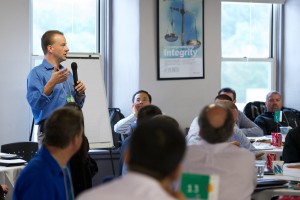I have been asked often lately why we focus most on employee engagement. My answer is the same now as it was when we founded the business (twenty years ago). Researching why some people choose to roll up their sleeves to do hard work, take responsibility for themselves, connect with others and ENGAGE while others get stuck and rarely leave their comfort zone; this never ceases to fascinate me. It seems so obvious from the outside but it rarely is from inside.
In December 2013, Gallup stunned the business world with a revelation that just three in ten American workers are engaged in their jobs and are willing to do all that they can to help their organizations and bosses succeed. Since the research posted there has been a hyper-focus movement in U.S. business to engage workers with a surprising outcome; organizations have, for the most part focused on boosting employee’s levels of happiness.
Our take on this: they are asking the right questions but going down the wrong road to nowhere otherwise known as a treadmill of disaster. Engagement is not about happiness; rather it is a discovery of deep meaning and the ability to be working in some capacity most days within a mission and a purpose, which one can relate to and feel a part of.
One of our greatest challenges has always been to create film-based products, which create transformative learning experiences that have lasting impact and emotional connection. Happiness and “being happy” have little to do with engagement and the sooner organizations and managers leading engagement discover this the sooner end learners can connect with their management and their job in a whole new way; and get meaning from it. Engagement is about finding and living with deep and true meaning and purpose; it is not about “Being Happy” or having more snacks at the break room or parties for team building.
An Excerpt From Fast Company, piece from Mark C. Crowley:
Bringing American Workplaces Back to Full Health: We Shouldn’t Be Trying to Make Workers Happy
“The idea of trying to make people happy at work is terrible,” Clifton (Gallup) said.
While admiring companies like Zappos, which intentionally fosters positive workplaces, he nevertheless believes a day-to-day focus on the fun aspects of happiness greatly miss the mark. This is because research shows that how a person feels about the work they do every day has the greatest impact on engagement by far.
“What companies will inevitably find is that the only way to make a person happy is to give them a job that matches well to their strengths, a boss who cares about their development, and a mission that gives them feelings of purpose,” Clifton said. “The belief that something gets better when you come and do your job, that’s as happy as you can be.”
Free Lunches Don’t Drive Achievement
“Free lunches and snacks have little direct impact on human performance,” Clifton insists, “and have the real potential of being destructive to achievement.”
On a vacation to Yellowstone National Park, Clifton noticed signs saying, “Do Not Feed The Bears,” almost everywhere he went. Concerned that all these postings were an indication that bears were mauling campers in unusual numbers, he sought out a park ranger for explanation.
“Those signs aren’t for your protection,” the ranger told him, “they’re here to protect the bears. What most people don’t understand is that when you feed a bear a peanut butter and jelly sandwich, they’ll never dig for roots again. Park visitors think all they’re doing is giving the bear a treat, but they end up ruining all those great animals’ lives.”
Clifton believes, “Rather than looking for all the ways that actualize people, they’re focused on free food. And that’s not only what people don’t want — it’s what’s going to spoil them. The ultimate act in workplace leadership is human development, not a focus on happiness or entertainment.”
Perks Aren’t Much Better at Driving Engagement
Although it is great for organizations to be generous with perks the spotlight for organizational cultures to work for should be placed on the companies who make more meaningful investments in growing their people.

“Many companies, like Google, offer perks because they create conveniences for employees, “but there’s no cause and effect in terms of engagement and high performance. I think perks make a little bit of difference to people, but the benefit is granular compared to a focus on individual expansion.”
Engagement Is Driven by What Many CEOs Still Believe Are Soft Practices
“What businesses really want,” is for employees to bring their initiative, commitment, and productivity to their jobs; but we can’t find any evidence that pay plays much if any role in driving this. The true connections are what many business leaders instinctively consider soft practices. But it’s almost as if the softer you go, the stronger the signal.” “The softer you go, the stronger the correlation.”
Research found that workers when asked about their engagement are really about a human wanting to develop, maximize their strengths, make a meaningful contribution, and feel valued. And we know that engagement happens automatically when these deeper needs get met.” But traditional beliefs about how best to motivate human beings continue to be the key reason why 70% of the working population is disengaged.
“The truth is many CEOs have been repelled by this idea that management must incorporate more heart to be successful,” “But now many are saying, ‘come a little bit closer, my dear.’ And this is because CEOs are desperate to win. They’re beginning to recognize that an authentically caring culture provides a clear and sustainable competitive advantage.”
Deep Engagement Can Actually Happen Quickly (and Utterly Transform an Organization)
Even now so many years later I find I am even more fascinated by this topic than ever before. Never had there been a better time to engage, to connect, and to transform your organization; it all begins with honesty, humility, respect (and a sense of humor). The real question is (as it is with most things that really matter): is the timing right? Is today the day to reboot and engage?
Are we scoring high in our engagement and agility assessments? Do our end learners feel connected to the vision and engaged by it personally?
All this work spending resources on the wrong treadmill. It is only a matter of time until it stops spinning on its own or you topple off and finally ask what it means to be truly engaging people so their eyes shine and they are fully connected. It is all about triggering something unique in a person to connect them to what is meaningful to them but once you do that, the possibilities for them, and the organization, are limitless.
Katalina Groh, July 22, 2015
Founder and Publisher, Groh™ author and speaker
Groh works with leaders and organizations to achieve breakthroughs in customer engagement, employee engagement, organizational culture, agility, identity, leadership development, talent-based assessments, entrepreneurship and well-being. Our professionals are thought leaders, scientists, and global HR executives who have strong experience leading enterprise-wide cultural enrichment and executive development.
Valued for strategic insight, ability to deliver global initiatives and high performance metrics. Resolves challenges. Delivers high-impact lasting engagement solutions. Creates online tools, film-based E Learning and guided social learning solutions. Leads large scale organizational change.
Creates industry-leading best practices. Designs unique tools and techniques for achieving the highest levels of organizational performance and growth. Remains at the forefront of employee engagement and has partnered with hundreds of organizations to help them create a sustainable culture of engagement.












